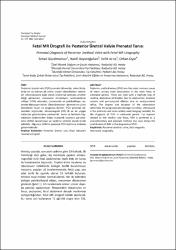Fetal MR ürografi ile posterior üretral valvin prenatal tanısı
Abstract
Posterior üretral valv (PÜV) prenatal dönemde, erkek fetüslerde
en sık izlenen alt üriner sistem obstrüksiyon nedenidir.
Obstrüksiyona bağlı olarak proksimal üretrada anahtar
deliği görünümü, mesanede distansiyon, vezikoüreteral
reflüye (VÜR) sekonder, üreterlerde ve pelvikaliksiyel sistemde
dilatasyon izlenir. Obstrüksiyonun derecesi ve süresi
böbrekteki hasarı ve prognozu belirler. PÜV prenatal dönemdeki teşhisinde, ultrasonografi (US) ilk ve en yaygın
kullanılan görüntüleme yöntemidir. Anne ve fetüsten kaynaklanan
nedenlerden dolayı manyetik rezonans görüntüleme (MRG) tamamlayıcı ve yardımcı yöntem olarak tercih
edilebilir. Olgumuz MRG’in prenatal PÜV teşhisine katkısını
göstermektedir. Posterior urethral valves (PUV) are the most common cause
of lower urinary tract obstruction in the male fetus in
antenatal period. These are seen with a Keyhole sing of
urethra, distention of bladder due to obstruction, bilateral
ureters and pelvicalyceal dilation due to vesicoureteral
reflux. The degree and duration of the obstruction
determine the prognosis and damage to kidney. Ultrasound
is the primarily and most widely used imaging modality for
the diagnosis of PUV in antenatal period. For reasons
related to the mother and fetus, MRI is prefered as a
complementary and adjutant method. Our case shows the
contribution of MRI in the diagnosis of PUV.
Source
Afyon Kocatepe Üniversitesi, Kocatepe Tıp DergisiVolume
13Issue
3Collections
- Makaleler [452]



















